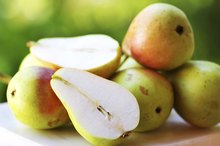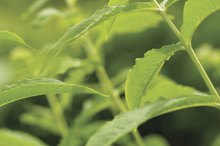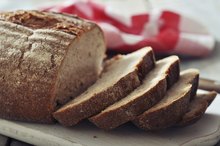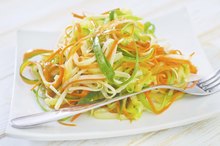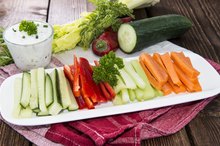What does fact checked mean?
At Healthfully, we strive to deliver objective content that is accurate and up-to-date. Our team periodically reviews articles in order to ensure content quality. The sources cited below consist of evidence from peer-reviewed journals, prominent medical organizations, academic associations, and government data.
- "Journal of the American Dietetic Association"; Position of the American Dietetic Association: Health Implications of Dietary Fiber; October 2008
- "Journal of the American Dietetic Association"; Position of the American Dietetic Association: Health Implications of Dietary Fiber; October 2008
- Office of Dietary Supplements; Vitamin C; November 2009
The information contained on this site is for informational purposes only, and should not be used as a substitute for the advice of a professional health care provider. Please check with the appropriate physician regarding health questions and concerns. Although we strive to deliver accurate and up-to-date information, no guarantee to that effect is made.
Unlike other nutrients, such as protein, carbohydrates and fat, your body cannot digest or absorb fiber. It travels through your digestive system relatively intact. While this may explain how it helps alleviate constipation, it may make you wonder how fiber in foods like mangoes can improve heart health, lower your risk of diabetes and make it easier for you to maintain a healthy weight.
Fiber Needs
Most Americans do not get enough fiber in their diets, the American Dietetic Association says 1. You need about 14 grams of fiber for every 1,000 calories consumed, or about 25 grams a day for women and 30 grams a day for men. Most Americans average about 15 grams of fiber a day. One-half of a small mango contains 2.9 grams of total fiber, meeting about 10 percent of your daily fiber needs.
- Most Americans do not get enough fiber in their diets, the American Dietetic Association says 1.
Soluble Fiber in Mangoes
List of Roughage Foods
Learn More
There are two types of fiber: soluble and insoluble 2. Soluble fiber is a type of fiber that dissolves in water to form a gel. It binds with fatty acids and prevents you from absorbing cholesterol, helping to lower your levels. Soluble fiber also delays stomach emptying, slowing the release of sugar into your bloodstream, which can help people with diabetes better manage their blood sugars. Mangoes are a good source of soluble fiber, containing 1.7 grams in half of a small fruit.
- There are two types of fiber: soluble and insoluble 2.
- Soluble fiber also delays stomach emptying, slowing the release of sugar into your bloodstream, which can help people with diabetes better manage their blood sugars.
Insoluble Fiber in Mangoes
Insoluble fiber is a type of fiber that does not dissolve in water. It adds bulk to stool, improving bowel function and helping to prevent constipation. Insoluble fiber also helps to control and balance your intestinal pH, which may help prevent microbes from producing cancer-causing substances, Gloria Tsang, R.D., of HealthCastle.com notes 2. In addition, including more insoluble fiber in your diet may help prevent you from developing Type 2 diabetes. A half of a small mango contains 1.2 grams of insoluble fiber.
- Insoluble fiber is a type of fiber that does not dissolve in water.
- Insoluble fiber also helps to control and balance your intestinal pH, which may help prevent microbes from producing cancer-causing substances, Gloria Tsang, R.D., of HealthCastle.com notes 2.
Mangoes and Diet
Calories in Half a Grapefruit
Learn More
Mangoes are also low in calories and a good source of vitamin C, folate and potassium. A 1-cup serving of cubed mango contains 99 calories, 60 milligrams of vitamin C, 71 micrograms of folate and 277 mg of potassium. Vitamin C is an important antioxidant that protects cells from oxidation that can lead to heart disease and cancer. Women of childbearing age need adequate intakes of folate to prevent neural tube defects in their unborn children. Increasing your intake of potassium can help keep your blood pressure within an acceptable range.
- Mangoes are also low in calories and a good source of vitamin C, folate and potassium.
- Women of childbearing age need adequate intakes of folate to prevent neural tube defects in their unborn children.
Related Articles
References
- "Journal of the American Dietetic Association"; Position of the American Dietetic Association: Health Implications of Dietary Fiber; October 2008
- HealthCastle.com; Fiber 101: Soluble Fiber vs. Insoluble Fiber; Gloria Tsang; November 2005
- USDA: Nutrient Database: Mangos, Raw
- Office of Dietary Supplements; Vitamin C; November 2009
- Andrews KW, and Pehrsson, PR. Individual Sugars, Soluble, and Insoluble Dietary Fiber Contents of 70 High Consumption Foods.
- Harvard University Health Services. Fiber Content of Foods in Common Portions. Adapted from Anderson JW. Plant Fiber in Foods. 2nd Edition. 1990 Li BW,
- USDA National Nutrient Database for Standard Reference, Release 20.
Resources
Writer Bio
Jill Corleone is a registered dietitian and health coach who has been writing and lecturing on diet and health for more than 15 years. Her work has been featured on the Huffington Post, Diabetes Self-Management and in the book "Noninvasive Mechanical Ventilation," edited by John R. Bach, M.D. Corleone holds a Bachelor of Science in nutrition.



